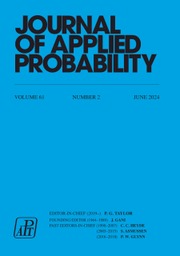Article contents
Sharp rates of convergence in the Hausdorff metric for some compactly supported stationary sequences
Published online by Cambridge University Press: 17 June 2025
Abstract
We study convergence rates, in mean, for the Hausdorff metric between a finite set of stationary random variables and their common support, which is supposed to be a compact subset of  $\mathbb{R}^d$. We propose two different approaches for this study. The first is based on the notion of a minimal index. This notion is introduced in this paper. It is in the spirit of the extremal index, which is much used in extreme value theory. The second approach is based on a
$\mathbb{R}^d$. We propose two different approaches for this study. The first is based on the notion of a minimal index. This notion is introduced in this paper. It is in the spirit of the extremal index, which is much used in extreme value theory. The second approach is based on a  $\beta$-mixing condition together with a local-type dependence assumption. More precisely, all our results concern stationary
$\beta$-mixing condition together with a local-type dependence assumption. More precisely, all our results concern stationary  $\beta$-mixing sequences satisfying a tail condition, known as the (a, b)-standard assumption, together with a local-type dependence condition or stationary sequences satisfying the (a, b)-standard assumption and having a positive minimal index. We prove that the optimal rates of the independent and identically distributed setting can be reached. We apply our results to stationary Markov chains on a ball, or to a class of Markov chains on a circle or on a torus. We study with simulations the particular examples of a Möbius Markov chain on the unit circle and of a Markov chain on the unit square wrapped on a torus.
$\beta$-mixing sequences satisfying a tail condition, known as the (a, b)-standard assumption, together with a local-type dependence condition or stationary sequences satisfying the (a, b)-standard assumption and having a positive minimal index. We prove that the optimal rates of the independent and identically distributed setting can be reached. We apply our results to stationary Markov chains on a ball, or to a class of Markov chains on a circle or on a torus. We study with simulations the particular examples of a Möbius Markov chain on the unit circle and of a Markov chain on the unit square wrapped on a torus.
Keywords
MSC classification
Information
- Type
- Original Article
- Information
- Copyright
- © The Author(s), 2025. Published by Cambridge University Press on behalf of Applied Probability Trust
References
- 1
- Cited by


